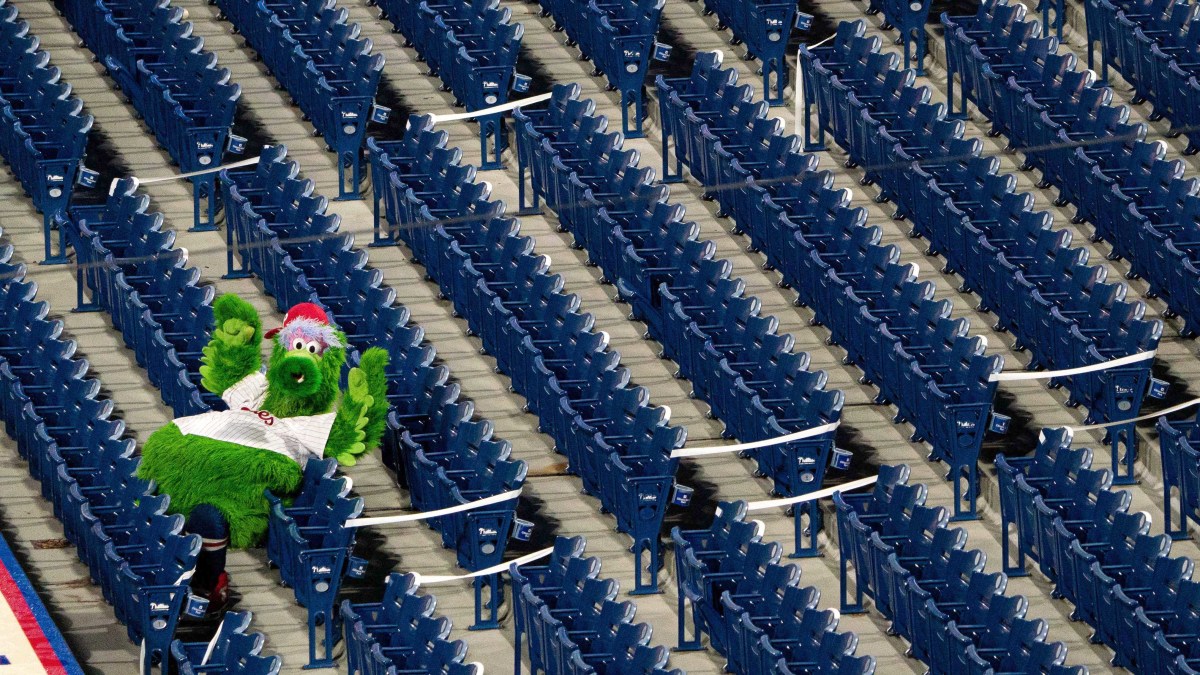Welcome to Baseball's Honeymoon Phase. How Long Will It Last?
PHILADELPHIA — In the bottom of the seventh inning, the left-field jumbotron at Citizens Bank Park delivered, in capital letters, a message to nobody in particular: “MAKE SOME NOISE.” Two batters later, Scott Kingery lined a ball into the seats in the left-field corner that tailed just foul of the pole and the piped-in artificial crowd noise obliged, letting out what sounded like a half-hearted cheer over a long foul ball. Welcome to Night 2 of MLB’s dystopian-sci-fi-movie-inspired experiment that is the 2020 season.
It was a real baseball game, that counts in the real standings, but it was also a disjointed smorgasbord of familiar rituals and makeshift adaptations. There were lineup introductions along each foul line; red, white and blue bunting hanging over railings; and perfectly clean baseball caps. There were also designated hitters in a National League park, pitchers carrying their own rosin bags and cardboard cut-outs staring back at them from behind home plate. They showed a recording of Kane Kalas singing the national anthem on a previous Opening Day, surrounded by fans in jackets and scarves. Didi Gregorius homered while wearing a mask.
In previous seasons, the Phillies have celebrated the home opener by parading the players in from the parking lot and having them walk through a tunnel of fans, down through the center-field seating area and onto the playing surface below. On Friday night, fans came right up to that same gate, but couldn’t come inside. Some honked car horns in the parking lot in the early innings, while others peered in through the bars, trying to catch a glimpse of the action. When pending free-agent catcher J.T. Realmuto came up to bat for the first time, the fans chanted, “Sign J.T.” loud enough for everyone in the park to make out the message. It was the only real in-person interaction between the team and its fans after four long months of waiting for baseball.
The Phillies’ opponents were the Miami Marlins—butt of many a joke this summer about games being played in empty stadiums. They flew in from a state where cases have surged so much that even a president who has frequently tried to downplay the concern people should have over the coronavirus has now finally canceled his upcoming convention there. Welcome to the Commonwealth of Pennsylvania, a state whose Department of Health declared earlier this week that even though the Phillies can play 30 games in this ballpark, and the Pirates can play 30 games 300 miles to the west, the Toronto Blue Jays are not welcome to tack on any more baseball games than have already been deemed permissible.
Many people like to say that sports are a distraction, and perhaps they will be for the rest of this summer, but it would have been impossible to sit down and watch a baseball game in any of the 14 parks that hosted them Friday and not think about the pandemic that delayed Opening Day to July.

While it would be great to focus on what we have, with baseball back in our lives, the glaring absence of fans in seats made it much easier to focus on what we don’t. The wide swaths of empty blue chairs in every direction made it keenly obvious. It was just eerie to see that the significance of the games on the field had been ratcheted up overnight from Summer Camp to the real thing, but without the energy in the park to match. Each vacuous thud of a wayward foul ball off an uninhabited piece of plastic or concrete drove it home further.
This week, baseball is in a honeymoon phase. A couple months ago, with phrases like pro rata and force majeure in the news, with days where it felt like we wouldn’t see MLB games until 2023, some fans were swearing up and down that they’d never come back. But for now it seems, anecdotally at least, that people have come back. The ones baseball hasn’t already lost over the years, that is.
But two months can be a long time—particularly with the rate at which time has passed for many of us in 2020. Two months ago was Memorial Day. Doesn’t exactly feel like just yesterday, does it?
Ever since the 60-game schedule was set, we have been told it’s a sprint. And that is true, relative to any MLB season anyone alive has ever seen. And sure, it’s exciting to think about a pennant race already being just a month away, with more teams in the hunt and major shifts in the standings possible in a short amount of time. But 60 games in 66 days can still be a grind. A normal baseball season is long and grueling, but chopping it down to two months doesn’t change the breakneck pace that makes it so taxing. The players are still in for a lot of nights at the park. A lot of travel. A lot of coronavirus tests. A lot of time spent worrying about whether or not they and their families are safe.
And it very well could be even more of a grind playing in front of so many empty seats. Players across sports often talk about feeding off the energy of the crowd, and it was notable that as the home team tried to battle back from a late deficit, there was none. The Phillies had three hits in the first seven innings and the limited options available to the fake-noise DJ didn’t quite have the nuance to simulate moods that specific.
For this night, though, everyone seemed to make the most of it. Elbow bumps were plentiful during player intros. Bryce Harper offered his customary bow to the invisible fans in right field before the first inning and tossed a ball into the stands after catching the third out. The Phanatic sat in the lower deck with an entire section to himself, gesticulating at the handful of people scattered around the park when he was displeased. It was all wholesome ballpark entertainment, but it’s hard to know for sure which of these will be season-long rituals and which will run out of steam when the novelty wears off.
It has been nearly a decade since the Phillies last made the playoffs, but the timing of their run from 2007–11, just a few years after they christened this ballpark, means that for many Philadelphians this brick building has always been a reminder of good times. The days when rally towels twirled and metal shook and the team won big games. Those moments have happened on this very field.
So watching Realmuto come up as the potential tying run, with two men on base in the eighth inning, when Opening Day would normally be a standing room only affair, it wasn't hard to think about what this stadium is like on its best days. Not just during the sellout streak that spanned four seasons, but last year, when Harper’s arrival triggered the biggest attendance jump in the majors. Realmuto grounded out to the pitcher. If any of his fans were still standing in the parking lot, they didn’t have any chants left in them. The last laugh went to the Marlins, whose dugout was lively with supportive chatter all night and audible throughout the park.
It will likely get easier, just to talk about baseball and not the circumstances in which it’s being played. To talk about bullpen management and strikeouts and real baseball complaints. For some, particularly in sports-crazed cities that take pride in hanging on each game, that moment may be Saturday.
There’s a lot we have lost in 2020, and the ability for baseball fans to watch players and baseball players to play in front of fans is relatively low on the list, all things considered. The 2020 season won’t be the same as we’re used to, but it’s here. Fans have waited and waited. And waited and waited. For this. And now, at a time when many have joked or complained (or a little of both) that every day in this recurring nightmare of 2020 is the same, at least the schedule says we are also supposed to have baseball day after day, too.
